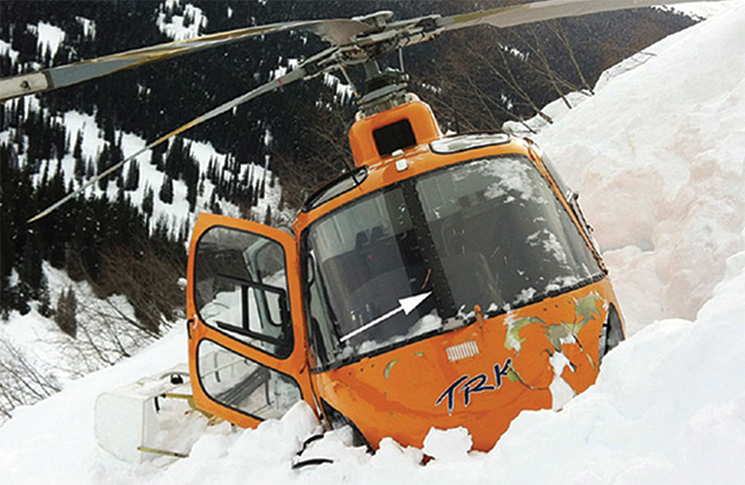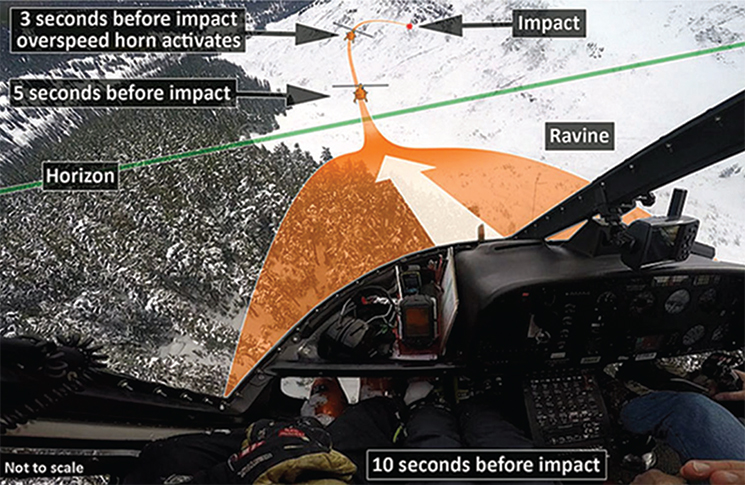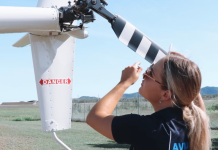The widely misunderstood phenomenon of servo transparency – or jack stall – can turn a helicopter pilot into a passenger – without any warning.
It had been a full day of back-country-heli-skiing. The last ski run was complete and the ski guide signalled it was time to head back to base camp in Colorado.
The Squirrel AS350 helicopter landed in the deep snow and everybody climbed aboard.
There wasn’t much room and everyone was packed in. The guide secured the skis in the external basket. The helicopter took off and turned around, flying over the snow-covered trees, skimming over white ridge lines and higher over the valleys.
Initially, the altitude was 150 feet above the terrain, however, the pilot descended lower and lower. The pilot pushed over one ridge line and the passengers felt themselves float slightly as the helicopter experienced low G.
Down into the ravine the helicopter descended and accelerated as the passengers laughed and whooped while filming the fun. Now the opposite ravine wall approached. The pilot pulled back on the cyclic to climb, then some left cyclic to follow the ravine downhill.
Wait – the aircraft won’t roll left! The surprised pilot feels as if the cyclic control is jammed – a brief moment of confusion as this doesn’t make any sense. As the pilot tries to process what is wrong, the helicopter rolls right and pitches up – the rotor overspeed horn is going off.
Some passengers are still whooping as if this is part of the fun. Too late, they realise the situation is serious. The helicopter is now too close to the far wall of the ravine and hits the snow-covered slope, ending up facing in the opposite direction.
The ski guide has the presence of mind to stop people leaving the aircraft until the engine is shut down and rotors are stopped. Fortunately, everyone survives with no injuries. All of this was captured on video. It was an unnecessarily dramatic end to what had already been an adventurous day of skiing.
Hydraulics and helicopters
Helicopters create lift and controllability by varying the pitch of the rotor blades. Varying the blade pitch is done by pitch control rods that act both collectively and cyclically.
As the blade pitch increases, the blade creates more total reaction as well as a pitching moment about the blade hinge line. This blade pitching moment acts against the forces applied through the pitch control rods and then back into the flight control system.
In small helicopters with small rotor blades, these forces are light. Some early helicopters had control systems that allowed the pilot to overcome these forces without hydraulic assistance. The Robinson R22 – the most popular helicopter type on the Australian register – still does without flight control hydraulics.
As helicopters became larger, the forces fed back through the control system became too tiresome for the pilot and so the flight controls had a hydraulic boost system added to prevent the pilot from feeling and having to work against these forces. Servo actuators were installed to allow hydraulic pressure to actuate the pitch control rods. This is known as an irreversible control system as the pilot does not feel the forces generated in the flight controls by the rotor blades.
If this single hydraulic system failed, the pilot could carefully fly the helicopter in a reduced envelope and overcome the feedback forces to make an emergency landing. As helicopters became even larger and heavier, a failure of a single hydraulic system meant the pilot did not have the strength to overcome these feedback forces; therefore, a second hydraulic system was added for redundancy.
Any flight condition that increases the blade-pitching moment will put the pilot closer to servo transparency – or frozen controls.
In this accident, the Squirrel AS350 had a single hydraulic boost system for the flight control system. (Some AS350s are fitted with dual hydraulic systems.) The manufacturer designed the hydraulic system so the flight controls cannot be over manipulated and exceed the helicopter’s certified flight envelope. This prevents overstress of the helicopter or its components. The hydraulic pressure is limited to just under 600 psi.
During aggressive manoeuvers, if too great a blade pitching is generated then the force that is fed back through the pitch control rods becomes large and exceeds the capacity of the 600-psi hydraulic system. This means the flight controls become heavy and, ultimately, momentarily frozen, until the helicopter manoeuvre aggressiveness is reduced either naturally or by lowering the collective.
Without further control manipulation, the blades will flap, slowing the aircraft and reducing the aggressiveness of the manoeuvre. This allows the hydraulics to resume moving the pitch rods again when the helicopter is back inside its certified flight envelope. However, this flap back can result in unusual attitudes in pitch and roll before the pilot regains control. The pilot could also reduce collective, decreasing the blade pitch on all blades at once, reducing the blade pitching moment and allowing the controls to move again.
If the helicopter is close to the ground or obstacles, then recovery from an unusual attitude may not be able to be completed before impact.
Transparent overload
Any flight condition that increases the blade-pitching moment will put the pilot closer to servo transparency – or frozen controls. High-pitch settings mean the blades are creating a lot of lift and a similarly increased blade-pitching moment that must be opposed by the pitch rods and hydraulic system. Heavy helicopter operating weights require more lift and, hence, higher-blade pitch angles.
Aggressive manoeuvring including pulling G will also increase the blade-pitch angle as more lift is required to roll and pull the helicopter through a manoeuvre. High-density altitude will require more blade pitch. High airspeeds require power to achieve and, as well as high pitch, there will be increased blade forces on the forward travelling blade due to the increased speed. All of these contribute to increased blade-pitching moments and reduced margin from servo transparency.
Airbus Helicopters has issued guidance on the servo transparency by a service letter and safety information notice. Servo transparency is also known as jack stall or servo reversibility. In this guidance, it says servo transparency can occur on any single hydraulic system helicopter if operated beyond its design flight envelope. It states specifically, ‘This aircraft phenomenon occurs smoothly and is not dangerous if properly anticipated by the pilot during an abrupt or high- load manoeuvre such as a high-positive G-turn or pull-up’.
In a clockwise-turning rotor system, the right-hand servo is the most highly loaded servo when aggressively manoeuvring. The pilot will introduce left cyclic to counter the loads and feel increasing forces to the point where they may feel the controls are jammed or frozen. Eventually, the helicopter will roll right and pitch up; the collective will reduce as the pitch-rod loads on the swashplate force the collective down.
This natural response is self-correcting and decreases the severity of the manoeuvre within about 2 seconds. This returns the control forces to normal allowing the pilot to fly a recovery. If the helicopter is close to the ground or obstacles, then recovery from an unusual attitude may not be able to be completed before impact. The pilot’s actions on encountering servo transparency are to immediately reduce the severity of the manoeuvre, allow the collective to reduce and smoothly correct the roll, while anticipating an increasing roll response as the servo transparency reduces. Some helicopters now have a sensor in the servo that will illuminate a LIMIT caution in the cockpit to indicate impending servo transparency.
Good airmanship would dictate that a pilot should understand whether servo transparency is a characteristic of the helicopter they are flying and allow sufficient margin to avoid frozen controls or ensure there is sufficient room to recover from the subsequent unusual attitude. Even if there is sufficient room to recover before hitting the ground, a large, unusual attitude recovery could be mishandled and result in mast bumping, drop-stop pounding or even excessive blade flapping that may contact the tail boom.
The surprised pilot feels as if the cyclic control is jammed.
A case in point
So back to the accident described in the introduction. The aircraft was heavy with a full passenger load. It was skimming over ridgelines and then bunted into a ravine. Speed was high and it accelerated even further as it descended into the ravine. The rate of descent was high – in the order of 5,000 feet per minute.
Now the helicopter was approaching the opposite side of the ravine and needed to alter its flight path to avoid terrain. A pull up and roll left to turn downhill at heavy weight and high speed was required. Probably an abrupt pull up considering how high the rate of descent was. However, the helicopter did not respond to the flight control inputs. Instead, it turned right, pitched up, flaring and over-speeding the rotor.

Miraculously, the helicopter presented itself to the terrain in an attitude that roughly matched the slope of the hillside, with the snow cushioning the collision. A classic case of servo transparency in both the conditions leading up to it and the response of the helicopter. The passengers weren’t the only people in the helicopter along for the ride – because the helicopter was low and close to the terrain, the pilot could do little to regain control of the helicopter before it impacted. The airspeed indicator was showing significant discrepancies from the GPS ground speed. This was postulated as possibly due to the static ports under the fuselage becoming temporarily blocked when previously landing in the deep snow to pick up the passengers.
By the time the pilot dived into the ravine, the 2 readings were almost aligned. The pilot stated this airspeed discrepancy had occurred previously and went away after a period due to the snow melting out of the static ports. Did the pilot really appreciate how fast he was flying the helicopter?
So, what would the next-day analysis from the armchair experts tell us the pilot should have done?
Everyone had a good time skiing. The passengers were obviously adventure seekers and enjoyed flying low and fast over the snow-covered wilderness below them. However, there are legal minimums for how low you can fly. Most people enjoy helicopter flights above these minimum heights and the people who want to fly lower don’t understand the risks they are asking the pilot to accept on their behalf.
However, being at low level, diving into a ravine and requiring a turning pull up to avoid terrain does not leave much room to prevent occurrence of a known characteristic of the helicopter. Thankfully, no one was injured.

A key question remains: how much transparency did the passengers have of the risks the pilot was accepting on their behalf when the helicopter conducted some low-level aggressive flying?





